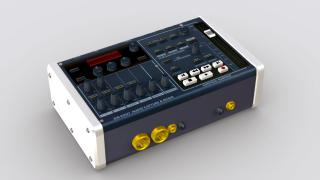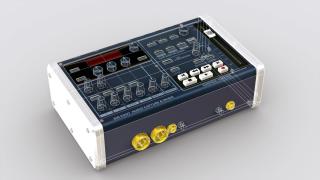-
Posts
5,412 -
Joined
-
Last visited
-
Days Won
89
Content Type
Profiles
Forums
Events
Everything posted by Fuchur
-
A model using Newton Dynamics, combined with the plugin "Multiple Copies / Multiple Imports" should help you very much... See you *Fuhcur*
-
do u have global space activated? see u *Fuchur*
-
Has.To do with changing bias and then trying to do a cfa. I reported this. You can select the part of the model, put in standard bias values (0.0.100) and the problem should be gone so you would have to set the bias values again manually. See u *Fuchur*
-
Do you have write-access for the folder A:M is installed in? And does A:M have write access to it? See you *Fuchur*
-
I'd say give him an image in which he is swinging next to a mirroring building and the real spidey (red one) is reflected as blackone (or visversa). See you *Fuchur*
-
Are we talking about creating a transparent background for video-footage which does not have the needed background (green or blue) to be keyed (not possible in A:M) or are we talking about a rotoscope for an animation to get the movement right? See you *Fuchur*
-
Do you think she thought something like "Damn I will look so stupid..."? 5% blur and speed of maybe 120-180° per second should be enough for such a thing... Render it with about 9 passes (you can try even less) and dont look too much on the single-images but on the animation that will come out... that would be my startingpoint... See you *Fuchur*
-

How to export from A:M to a game-engine...
Fuchur replied to Fuchur's topic in A:M Tutorials & Demos
You would not get back to the original model... that one would be very hard to animate, rig or transfer... but you could use it to create a displacementmap from it (ZBrush can do that... very likely 3d Coat can too) or you could use something like TransferAW to transfer the animated bones-data to your high-poly-model if you need to... anyway I dont see the big need for that... using a displacementmap and a well layouted object would be enough to create very astonshing things. Keep in mind: Using such programms creates tons of unneccessary polygons. for most models we are talking about 60 - 80% of not needed polygones or at least unneeded once for patch-based situations... so in most cases you should be able to create a very cool looking model quite easily to be useable in A:M. It would still be work, but it should make the process much easier. And keep in mind: We are talking about game-objects here too... high-poly-models with 500.000 polygones or more are not gonna be working with any kind of game-engine. (you normally need more than one and then we are very fast talking about several millions of polys...) See you *Fuchur* -
100 passes? that will take forever... try 9 or 16... should be enough for most things... often even 4 are enough... (so maybe not in your situation...) See you *Fuchur*
-

How to export from A:M to a game-engine...
Fuchur replied to Fuchur's topic in A:M Tutorials & Demos
What I already asked for as a feature-request is the Retopology-Tool for A:M. I think this is the easiest way to get this pipeline working... If you have a model done outside of A:M, bring it as 3d-Rotoscope (more or less a prop-object) to A:M, use something like "Snap to 3d Rotoscope" / "Snap to Polygon-Surface" in A:M (done already by for example 3d Painter) and model your new geometry around it with splines. The next thing would be to transfer the UV-cordinates to the newly created patch-model (a bit like TransferAW does it with Weights only the other way round) and we would have a very fast and workable pipeline from the polyworld to A:M and of course out again. Any automatic importer has problems with the continuity of splines, but this would be a great way to get around that problem by letting these issues be solved by the user, who is the best guy for the job anyway. The cool thing about it: Most stuff of it is already to some extend available. There are algorithms to track a surface (>Surface-Constraint) there is the possibility to import Polygon-Object (> Props). The UV-part may be a little bit more difficult, but should be techniqually doable too. What needs to be implemented for that would be the possibility to import a prop (uneditable) to a modelling-window or if that is too much trouble: We can although model in the Chor using the prop... so the first thing would to do would be "Snap to Surface" for the mouse. Steffen is working on OpenCL-implemetation these days and very ocuppied with that, but he did assign the featurerequest already... and maybe we would need that to slide over the surface with the mouse... This would be a way to open the two worlds to eachother and I am very sure that this would be a great way to attract more people to A:M and giving us many opportunities to work on projects with other guys, create amazing stuff and be a source of great inspiration... I'd love to see that! But it will certainly still take some time before this can be done. Keep in mind: Steffen is already working very hard on A:M and he does it as a hobby... anway, it may be possible and is the only way I see to connect both worlds (Patches and Polygones) in a useable way. See you *Fuchur* PS: I tested 3d Coat a little and I find it to be a very nice addition to A:M with the lowest price-tag out there for such features especially Voxel-modelling, etc. seems to be cool... So I cant test it, because this is still a little to pricey to just buy it and see how it works with A:M's importer... there were others here who did it... as soon as A:M has the retopolgy-tools I will however very certainly buy it to cooperate with A:M! -
That is for what an alpha-channel is used. You will need to choose a TGA (32bit) or a PNG-file-texture. (or EXR, but that is a different story) All others won't work. Here is a video-tutorial for creating alpha-channels. Alpha-channels don't have to be white or black, but they can be any grey-level between it. This defines half-transparencies... If you have more questions, let me know. I may create a tutorial on doing it in future too, but till now that should give you your answer about that. See you *Fuchur*
-
Hi Antonahill, do you still have the master0.lic-file that Jason sent you? Did you try to copy this one into the Animation:Master install-folder after fixing the permissions? I am not sure if it will work, since you upgraded to Lion and the licence-file is likely keyed to the version of your OS to, so I am not sure about that. If you tried that already, I am sorry but you will have to wait for Jason to fix this. Your licence-key seems to be already activated once and like that you can't activate it again without a new activation key. You will of course get one for free in your situation, but that has to be done by Jason and I am quite sure that he is not in the office on the weekend. Sorry that you have problems with the activation. Hopefully you will get it fixed very soon. If you upgraded to lion, make sure to use only the latest v16-version. I think older once can't be run on it, if I remember right. (I am myself a Windows-user, but I think I heard something about that, because Apple dropped compiler-support for the previously used compiler-versions with Lion). See you *Fuchur*
-
... and yes, A:M can even be used for such things... so it is not specially designed for it. Characteranimation is what A:M can do the best. Most other things are possible but are not the main intend of A:M. I have done product-visualisations, game-assets-creation, elearning-animations, motiongraphics for video-editings and effect-work with A:M too. And totally yes: A:M is fun. This is of course only my own opinion, but compared to other brands it is much more fun than anything else I have tested... See you *Fuchur*
-
I think you need to show more weight in her movement... it seems like she could move the sword around just from here wrist... make the sword-top follow the rest... the power is not coming from the top but from the handle of ths sword, so the top should follow the handle-movement and not be at the exact same time. The sword is although crossing through the axe (in the sideview it is very easy to see). But all in all: Very cool done! I couldn't have done it that nicely... See you *Fuchur*
-
If A:M's rendering speed has been keeping up with Maya, that's awesome. I appreciate this information, as besides speed, GPU rendering is so attractive because it keeps my CPU temps lower in my laptop. What do you need such low CPU temps for? Did you overclock it? See you *Fuchur*
-
Yes it is, but no it is in general not faster. The biggest advantage over polygone based methods is, that you can go to any resolution you want without having to readjust your model, because the precision level of patch is setted automatically to show for example round edges round all the time. Polygones have to be adjusted manually. That means you may have to work with proxy-models and final-models, etc. which is not necessary for A:M. Depending on the amount of polygones you are using it can be faster or less fast than A:Ms rendering. It highly depends on what you want and how precise it have to be for you. For now, A:M has no GPU-rendering, so GPU rendering can be much faster. (depending on the GPU and the CPU compared) However GPU-rendering will become available soon. It is currently in developement and will be based on OpenCL. (> compatible for ATI and Nvidia-cards). I don't know exactly what Houdini uses there, but it is possible that they only support CUDA. And CUDA is not ATI-compatible. See you *Fuchur*
-
Hi Southpawami, welcome to the forum . Till now there is no Collada-import / export in A:M. You can however use the directX-export-plugin to get A:M to export to Collada. For a workflow for that see my signature about FBX-Pipeline to Unity / DirectX-Pipeline to Quest3d. It does the same with the FBX-format and it will although work with the collada-fileformat. There is no realy way to import Collada-files to A:M till now. It may be introduced in future, but till now the import is only possible for OBJ, 3ds, PLY, LWO and DXF. In general, importing from a polyformat to A:M is not easy, so doable, depending on the object you want to import. See you *Fuchur*
-
It depends... it can make sense to weight for example the kneecap in another way than the hollow of the knee, because you want to preserve the "disc" shape, etc. Without an example it is hard to say if it is good or bad behaviour to do it. See you *Fuchur*
-

How to export from A:M to a game-engine...
Fuchur replied to Fuchur's topic in A:M Tutorials & Demos
Yes, I think you are right... it is just one of the biggest industries in the 3d area and like that will very likely output more innovations than other stuff.. See you *Fuchur* PS: Just to let you know: In another thread I posted another small Unity3d-example showing of some infos about my new audiointerface Roland VS-100. Hope you enjoy it! LINK -
Thanks But I am very sure you could have created that image too . Here is another test I did with A:M and Unity3d. Turn it around and see how it looks. There are some texture-problems which I will refine later. See you *Fuchur* roland_vs_100_turn_around.zip
-
Hi guys, just wanted to show you a little bit of my latest A:M work... I started to model a audio-interface based on my new Roland VS-100. Most of the work was to create the texture for it. Comments are of course welcome . See you *Fuchur* PS: I although attached an image with the wireframe overlayed. As you can see, the geometry is really quite simple.
-
I would recommend you to first render to image-sequences like TGA or EXR (depending on what you want to do with it afterwards). After that you can create an avi with it and will not loose your rendering if something goes wrong. After rendering the images you can use A:M or an external programm to produce a movie-file with it. So first of test if you can output images. If you have done that, try to create a movie-file from the images with A:M. -------------------------------------------------------------------------------------- To create a movie-file from an image-sequence: - Right-click on the "Images"-folder and choose "Import as Image Sequence". - In the opening filebrowser, click on the first image of the sequence and make sure the little checkbox "import as imagesequence" is checked at the left bottom of the filebrowser-window. - Hit open. - Right-click on the newly imported image-sequence and choose "Save As". - Choose your outputformat, etc. - Hit save as. (this description is taken from my memory, so there may be some buttons etc. which may be named a little bit different, but you should see what I am talking about.) See you *Fuchur*
-

How to export from A:M to a game-engine...
Fuchur replied to Fuchur's topic in A:M Tutorials & Demos
I think about the realtime-stuff you are totally right, so I don't think that a game-engine is the most easy way to create movies with it. A little too hard to create different motions which are not predefined with it... Steffen is currently working on OpenCL-integration (graphiccard based calculations, which can speed up some operations mainly connected to rendering) which is a very promising technology. It can speed up calculations in certain areas with a single graphiccard compared to a multi-core-computer (4x for example) for about 1000%. That would be a huge performanceboost and would make it easier to use even very advanced techniques like AO or Radiosity in a much faster way. And dont forget: We already gained much performance with the release of v16. Gameengines are very well suited for games and 3d-applications. Movies need a little more of preperation and while rendering and previewing your output will very likely become realtime, the creation-part will not be like that. It is one of the best things about 3d-animations: You can always go back again, move the hand a little closer to the body because it looks a little better etc. That is the stuff that game-engines can not do too easily. Playing predefined actions is their strength. Not altering them. See you *Fuchur* -
Great looking texture... I think it is a little bright but other than that: Amazing . See you *Fuchur*










